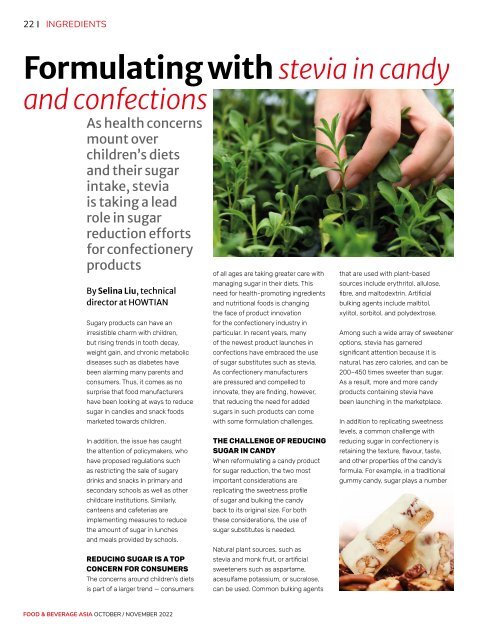Food & Beverage Asia October/November 2022
Food & Beverage Asia (FBA) is the leading source of food and beverage news in Asia since 2002. FBA delivers a comprehensive view of the food and beverage landscape, spanning across the latest health and nutrition trends and industry innovations in ingredients, recipe formulations, food science, sustainability, packaging, and automation, as well as advancements in agri and food-tech.
Food & Beverage Asia (FBA) is the leading source of food and beverage news in Asia since 2002. FBA delivers a comprehensive view of the food and beverage landscape, spanning across the latest health and nutrition trends and industry innovations in ingredients, recipe formulations, food science, sustainability, packaging, and automation, as well as advancements in agri and food-tech.
Create successful ePaper yourself
Turn your PDF publications into a flip-book with our unique Google optimized e-Paper software.
22<br />
INGREDIENTS<br />
Formulating with stevia in candy<br />
and confections<br />
As health concerns<br />
mount over<br />
children’s diets<br />
and their sugar<br />
intake, stevia<br />
is taking a lead<br />
role in sugar<br />
reduction efforts<br />
for confectionery<br />
products<br />
By Selina Liu, technical<br />
director at HOWTIAN<br />
Sugary products can have an<br />
irresistible charm with children,<br />
but rising trends in tooth decay,<br />
weight gain, and chronic metabolic<br />
diseases such as diabetes have<br />
been alarming many parents and<br />
consumers. Thus, it comes as no<br />
surprise that food manufacturers<br />
have been looking at ways to reduce<br />
sugar in candies and snack foods<br />
marketed towards children.<br />
In addition, the issue has caught<br />
the attention of policymakers, who<br />
have proposed regulations such<br />
as restricting the sale of sugary<br />
drinks and snacks in primary and<br />
secondary schools as well as other<br />
childcare institutions. Similarly,<br />
canteens and cafeterias are<br />
implementing measures to reduce<br />
the amount of sugar in lunches<br />
and meals provided by schools.<br />
REDUCING SUGAR IS A TOP<br />
CONCERN FOR CONSUMERS<br />
The concerns around children’s diets<br />
is part of a larger trend — consumers<br />
of all ages are taking greater care with<br />
managing sugar in their diets. This<br />
need for health-promoting ingredients<br />
and nutritional foods is changing<br />
the face of product innovation<br />
for the confectionery industry in<br />
particular. In recent years, many<br />
of the newest product launches in<br />
confections have embraced the use<br />
of sugar substitutes such as stevia.<br />
As confectionery manufacturers<br />
are pressured and compelled to<br />
innovate, they are finding, however,<br />
that reducing the need for added<br />
sugars in such products can come<br />
with some formulation challenges.<br />
THE CHALLENGE OF REDUCING<br />
SUGAR IN CANDY<br />
When reformulating a candy product<br />
for sugar reduction, the two most<br />
important considerations are<br />
replicating the sweetness profile<br />
of sugar and bulking the candy<br />
back to its original size. For both<br />
these considerations, the use of<br />
sugar substitutes is needed.<br />
Natural plant sources, such as<br />
stevia and monk fruit, or artificial<br />
sweeteners such as aspartame,<br />
acesulfame potassium, or sucralose,<br />
can be used. Common bulking agents<br />
that are used with plant-based<br />
sources include erythritol, allulose,<br />
fibre, and maltodextrin. Artificial<br />
bulking agents include maltitol,<br />
xylitol, sorbitol, and polydextrose.<br />
Among such a wide array of sweetener<br />
options, stevia has garnered<br />
significant attention because it is<br />
natural, has zero calories, and can be<br />
200–450 times sweeter than sugar.<br />
As a result, more and more candy<br />
products containing stevia have<br />
been launching in the marketplace.<br />
In addition to replicating sweetness<br />
levels, a common challenge with<br />
reducing sugar in confectionery is<br />
retaining the texture, flavour, taste,<br />
and other properties of the candy’s<br />
formula. For example, in a traditional<br />
gummy candy, sugar plays a number<br />
FOOD & BEVERAGE ASIA OCTOBER / NOVEMBER <strong>2022</strong>


















